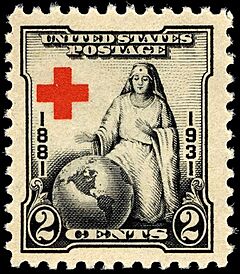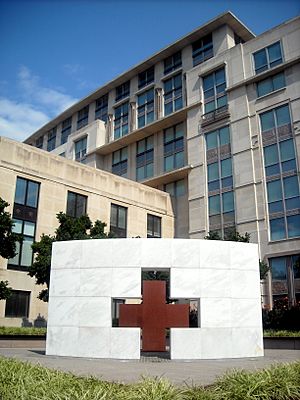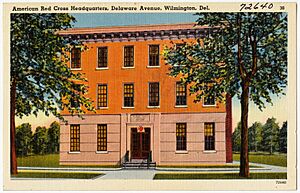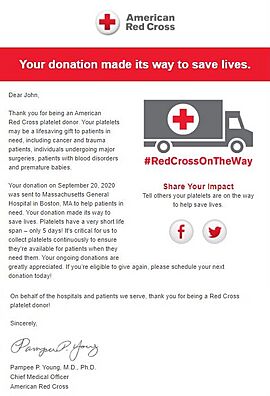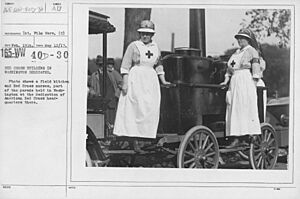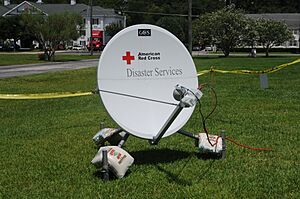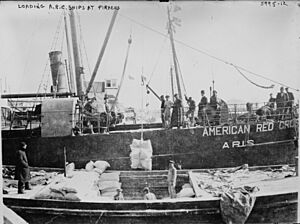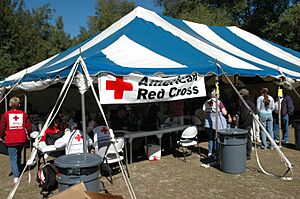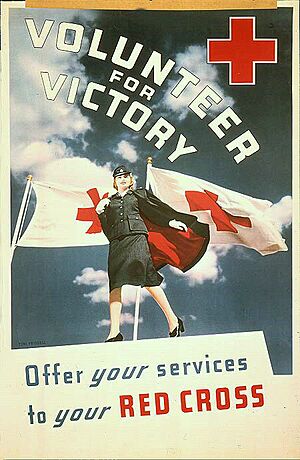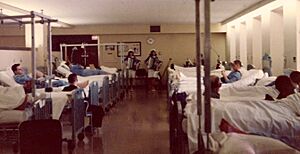American Red Cross facts for kids
 |
|

|
|
| Formation | May 21, 1881 |
|---|---|
| Founder | Clara Barton |
| Type | Charitable organization |
| Legal status | Instrumentality of the United States and a body corporate and politic 501(c)(3) organization |
| Purpose | Humanitarian aid |
| Headquarters | American Red Cross National Headquarters |
| Location |
|
|
Region served
|
United States |
|
President
|
Gail J. McGovern |
|
Main organ
|
Board of Governors |
|
Revenue
|
US$2.83 billion (2021) |
The American National Red Cross, is a nonprofit humanitarian organization that provides emergency assistance, disaster relief, and disaster preparedness education in the United States. It is the designated US affiliate of the International Federation of Red Cross and Red Crescent Societies and the United States movement to the International Red Cross and Red Crescent Movement.
The organization offers services and development programs.
Contents
- History and organization
- Blood services
- Training services
- Disaster services
- Disaster responses
- 1908 Messina earthquake
- Role in the United States occupation of Nicaragua
- Role in World War One
- Role in Spanish Flu Outbreak of 1918
- Interwar European reconstruction
- Russian revolution
- Role in World War Two
- 2005 hurricanes
- Comair Flight 5191
- 2007 tornadoes
- Minneapolis bridge collapse
- 2023 Hawaii wildfires
- International services
- Service to the Armed Forces
- See also
History and organization
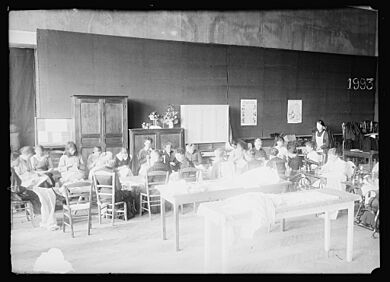
American Red Cross workplace, Memphis TN, c. 1898
|
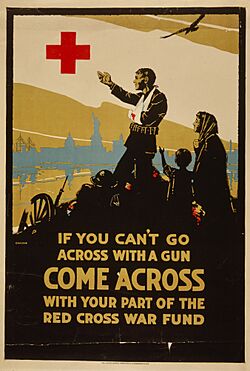
American Red Cross WWI poster
|
Founders
Clara Barton established the American Red Cross in Dansville, New York, on May 21, 1881, and was also the organization's first president. She organized a meeting on May 12 of that year at the house of Senator Omar D. Conger (R, MI). Fifteen people were present at the meeting, Conger and Representative William Lawrence (R, OH) (who became the first vice president) to discuss the start of the American Red Cross. The first local chapter was established in 1881 at the English Evangelical Lutheran Church of Dansville.
Jane Delano (1862–1919) founded the American Red Cross Nursing Service on January 20, 1910.
Clara Barton
Barton founded the American chapter after learning of the Red Cross in Geneva, Switzerland. In 1869, she went to Europe and became involved in the work of the International Red Cross during the Franco-Prussian War. She was determined to bring the organization to America.
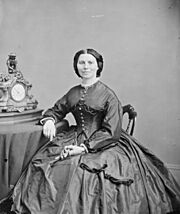
Barton became President of the American branch of the society, known as the American National Red Cross in May 1881 in Washington. The first chapters opened in upstate New York, where she had connections. John D. Rockefeller and four others donated money to help create a national headquarters near the White House. The abolitionist Frederick Douglass, a friend of Barton's, offered advice and support as she sought to establish the American chapter of Red Cross. As Register of Deeds for the District of Columbia, Douglass also signed the American Red Cross's original Articles of Incorporation.
The next major disaster was the Johnstown Flood on May 31, 1889. Over 2,209 people died, and thousands more were injured in or near Johnstown, Pennsylvania, in one of the worst disasters in U.S. history.
Progressive reform
Many within the organization became frustrated with Barton's leadership style, and Barton resigned from the organization in 1904.
Professional social work experts took control and made the group a model of Progressive Era scientific reform. New leader Mabel Thorp Boardman consulted with senior government officials, military officers, social workers, and financiers. William Howard Taft was especially influential. They imposed an ethos of "managerialism", transforming the agency from Barton's cult of personality to an "organizational humanitarianism" ready for expansion.
Among the notable disasters of the Progressive Era that featured American Red Cross involvement was the sinking of the RMS Titanic in 1912. The New York City chapter joined with the Charity Organization Society to provide funds to survivors and the dependents of those who perished.
Leadership
Recent presidents and CEO s include Gail J. McGovern, Elizabeth Dole, Bernadine Healy, Mary S. Elcano, Mark W. Everson and John F. McGuire. In 2007, U.S. legislation clarified the role for the Board of Governors and that of the senior management in the wake of difficulties following Hurricane Katrina. Members of the board of governors other than the chairman are elected at the annual meeting of chapter delegates. The board appoints the chief executive officer.
Ranking
As of April 2023, the American Red Cross scores four out of four stars at Charity Navigator and A− at CharityWatch.
In 1996, the Chronicle of Philanthropy, an industry magazine, released the results of the largest study of charitable and nonprofit organization popularity and credibility. The study showed that ARC was ranked as the third "most popular charity/non-profit in America" of over 100 charities researched, with 48% of Americans over age 12 choosing "Love" or "Like A lot" to describe it.
Notable members
- Inez Mee Boren, organizing chairwoman of the Lindsay Strathmore Branch of the American Red Cross
- Ida F. Butler, National Nursing Director from 1936 to 1939
- Naomi Deutsch
- Sally S. Emory, vice-chairwoman Board of American Red Cross
- Inglis Fletcher, originator of Junior Red Cross Hospital program in Spokane Public Schools
- George Ryerson Fowler, founder of the Brooklyn Red Cross (1884)
- Laura E. Frenger, Executive, Home Service Sec. American Red Cross for eight years
- Thora B. Gardiner, secretary of the County Chapter of the American Red Cross
- Nellie A. Goodhue, on Board of Directors of Local Chapter American Red Cross
- Sharlot Mabridth Hall, American Red Cross
- Wilhelmina Harper, American Red Cross Chicago
- Laura Adrienne MacDonald, member
- Virginia Keating Orton, member of Board of American Red Cross
- Genevieve H. Sanford, chairwoman of Red Cross Home Service Aberdeen
- M. Elizabeth Shellabarger, Director of Red Cross Nursing in Albania and Montenegro (1921–22)
- Nancy Ellicott Tomlinson, 3 years with Red Cross in Pacific Area, Executive Secretary, American Red Cross
- Violet Richardson Ward, taught water safety classes
- Gertrude B. Wilder, secretary of the San Bernardino chapter of the American Red Cross
- Basilio J. Valdes, first Chief-of-Staff of the Armed Forces of the Commonwealth of the Philippines from 1939. Was Deputy Commissioner for the American Red Cross in Europe after World War I.
Blood services
Blood donation
ARC supplies roughly 45% of the donated blood in the United States, which it sells to hospitals and regional suppliers. Community-based blood centers supply nearly 50% and approximately 5% is collected directly by hospitals. In December 2004, ARC completed its largest blood processing facility in the United States in Pomona, California, on the campus grounds of California State Polytechnic University, Pomona.
-
American Red Cross (Oklahoma City)
Tissue services
For more than 50 years, ARC provided allograft tissue for transplant through sales in its Tissue Services Program. It cared for thousands of donor families who donated tissue and sold the tissue to more than 1 million transplant recipients. At the end of January 2005, ARC ended its Tissue Services program to focus on its primary missions of Disaster Relief and Blood Services.
Plasma services
A leader in the plasma industry, ARC provides more than one quarter of the nation's plasma products. Red Cross Plasma Services provides plasma products that are reliable, cost-effective and as safe as possible.
In February 1999, ARC completed its "Transformation", a $287 million program that re engineered Red Cross Blood Services' processing, testing, and distribution system and established a new management structure.
As of 2011, ARC was no longer in the Plasma Services industry. It supplies Baxter BioSciences with items for manufacturing plasma products.
Nucleic acid testing
On March 1, 1999, ARC became the first U.S. blood bank to implement a nucleic acid testing (NAT) study. This process is different from traditional testing because it looks for the genetic material of HIV and hepatitis C (HCV), rather than the body's response to the disease.
The NAT tests for HIV and HCV has been licensed by the U.S. Food and Drug Administration (FDA). These tests detect the genetic material of a transfusion-transmitted virus like HIV without waiting for the body to form antibodies, potentially offering an important time advantage over current techniques.
Leukoreduction

Leukocytes (white blood cells) help fight off foreign substances such as bacteria, viruses, and abnormal cells. In fact, these foreign leukocytes in transfused red blood cells and platelets are often not well tolerated and have been associated with some types of transfusion complications. Leukocytes in stored blood products can have a variety of biological effects, including depression of immune function, which can result in organ failure and death. Because whole blood is rarely used for transfusion and not kept in routine inventory, leukoreduced red blood supplies are critical. After collection, the whole blood is separated into red cells and plasma by centrifugal. A preservative solution is mixed with the red cells and the component is filtered with a leukoreduction filter. The shelf life of this product is 42 days.
ARC is moving toward system-wide universal prestorage leukocyte reduction to improve patient care. From 1976 to 1985, the FDA received reports of 355 fatalities associated with transfusion, 99 of which were excluded from further review because they were unrelated to transfusion or involved hepatitis or HIV/AIDS. While the FDA has not yet made leukoreduction a requirement, ARC took a leading role in implementing this procedure with a goal of leukoreducing all blood products. More than 70% of ARC red blood cell components undergo prestorage leukoreduction, a filtering process performed soon after blood is donated.
Research
ARC operates the Jerome H. Holland blood laboratory in Rockville, Maryland. Each year, it invests more than $25 million in research activities at the Holland Laboratory and in the field.
Cellular therapies
ARC offers cellular therapies; this treatment involves collecting and treating blood cells from a patient or other blood donor. The treated cells are introduced into a patient to help revive normal cell function, replace cells that are lost as a result of disease, accidents or aging, or to prevent illnesses from appearing.
Training services
Training Services is one of the five divisions of the American Red Cross, responsible for providing health and safety training to the general public as well as the workforce. In fiscal year 2017 the American Red Cross trained 2.28 million people how to save lives through their First Aid, CPR or AED courses, water safety and care giving programs. There are a wide variety of course offerings available:
- Administering Emergency Oxygen
- Advanced Life Support
- Anaphylaxis and Epinephrine Auto-Injector
- Asthma Inhaler Training
- Babysitter's Training
- Basic Life Support
- Bloodborne Pathogens Training
- California Child Care
- CPR/AED for Professional Rescuers
- Emergency Medical Response
- First Aid/CPR/AED (English and Spanish)
- Hands-Only CPR
- Learn to Swim
- Lifeguard Management
- Life guarding
- Longfellow's WHALE Tales
- Nurse Assistant Training
- Pediatric Advanced Life Support
- Responding to Emergencies
- Safety Training for Swim Coaches
- Title 22 (California First Aid for Public Safety Personnel)
- Water Safety
- Wilderness and Remote First Aid
In addition to basic level certifications in the above courses the American Red Cross also offers Instructor level courses and Instructor Trainer (IT) level courses. Instructor level courses are designed to teach participants how to become instructors for American Red Cross courses, whereas Instructor Trainer courses (also known as Instructor Trainer Academies) are designed to certify current instructors to become Instructor Trainers, or people who can teach Instructor level courses.
Training Services has an online store where you can purchase supplies including First Aid Kits, CPR key chains, flashlights, and emergency radios.
2018 mannequin change
In early 2018 all courses offered by the American Red Cross switched to Brayden/BigRed Manikins. The investment cost $1.8 million and increased participants' understanding of the purpose of compressions during CPR. These Manikins have LED lights that mimic blood flow through the body and to the brain, giving students instant visual feedback on their technique.
Course offerings
There are three entities that can run American Red Cross courses; The American Red Cross, Authorized Providers, and Licensed Training Providers. The American Red Cross runs many of its own courses that can be conducted on land such as First Aid/CPR/AED and Basic Life Support for Healthcare Providers. There are a number of courses that require aquatic facilities to run, such as Lifeguarding and Water Safety Instructor. These courses are generally left to Authorized Providers (colleges, government agencies, fire departments, community centers) and to Licensed Training Providers (LLC. or Inc.).
Scientific Advisory Council
The Scientific Advisory Council is a panel including over 50 nationally recognized medical, scientific, aquatics, and academic experts from across the United States.
Disaster services
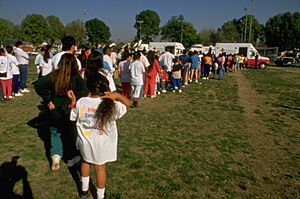
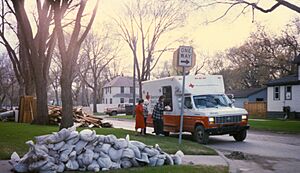
Each year, ARC responds to more than 60,000 disasters, including house or apartment fires (making up the majority), hurricanes, floods, earthquakes, tornadoes, hazardous materials spills, transportation accidents, explosions and other natural and man-made disasters.
Although ARC is not a government agency, its authority to provide disaster relief was formalized when, in 1905, it was granted a congressional charter to "carry on a system of national and international relief in time of peace and apply the same in mitigating the sufferings caused by pestilence, famine, fire, floods, and other great national calamities, and to devise and carry on measures for preventing the same." The charter is not only a grant of power but also an imposition of duties and obligations to the nation, to disaster victims and to the people who support its work with their donations.
Disaster relief focuses on emergency disaster-caused needs. When a disaster threatens or strikes, ARC provides shelter, food and health and mental health services (Psychological First Aid) to address basic human needs. The core of American Red Cross disaster relief is assistance to individuals and families to enable them to resume their normal daily activities. The organization provides translation and interpretation when necessary, and maintains a database of multilingual volunteers.
At the local level, ARC chapters operate volunteer-staffed Disaster Action Teams.
ARC feeds emergency workers of other agencies, handles inquiries from concerned family members outside the disaster area, provides blood and blood products to disaster victims and helps those affected by a disaster to access other resources. It is a member of National Voluntary Organizations Active in Disaster (VOAD) and works closely with other agencies such as Salvation Army and Amateur Radio Emergency Service with whom it has memorandums of understanding.
ARC works to encourage preparedness by providing important literature on readiness. Many chapters also offer free classes to the general public.
A major misconception among the general public is that ARC provides medical facilities, engages in search and rescue operations or deploys ambulances. Instead, first responder roles are left to government agencies as dictated by the National Response Framework. Red Cross societies outside the U.S. may provide such functions; for example, the Cruz Roja Mexicana (Mexican Red Cross) runs a national ambulance service. Furthermore, American Red Cross Emergency Response Vehicles (ERVs) look similar to ambulances. These ERVs instead are designed for bulk distribution of relief supplies, such as meals, drinks and other relief supplies. Although ARC shelters usually assign a nurse to the facility, they are not equipped to provide medical care beyond first aid.
Disaster Services Workforce
The Disaster Services Workforce (DSW) system enrolls volunteers from ARC chapters into a national database of responders, classified by their ability to serve in one or more activities within groups. Services include feeding and sheltering ("mass care") warehousing, damage assessment, accounting, communications, public affairs, counseling and others. Responders complete training for the specific services they want to offer, first aid and CPR.
Disaster responses
1908 Messina earthquake
In 1908 an earthquake and tsunami devastated the area surround the Strait of Messina. The American public donated nearly $1 million to the American Red Cross which was sent to Italy via the State Department, alongside $800,000 in public funds. The decision to use the State Department to distribute funds, rather than sending them directly to the Italian Red Cross, was indicative of the organization's shift away from the International Red Cross movement and towards US interests. This was the ARC's first major response to an international civilian disaster.
In December of that year two Americans, Harry Bowdoin and Charles King Wood, were in Taormina when the earthquake occurred. Mr. Bowdoin was spending the winter in Taormina with his invalid mother and Mr. Wood was an artist who had lived in Taormina for several years. These two men entered upon the work of relief answering the call of the Red Cross.[110] Afterwards, the Italian government conferred upon the two men the honorific of "Cavaliere". Bowdoin and Wood were two of the twenty-one recipients of the American Red Cross silver medal for "specially meritorious service" for that year.
Before 1908, the U.S. Congress had only rarely allocated funds for natural disasters; likewise, the level of funding given to Italy was also unprecedented. The ARC's aid to Italy carried important diplomatic meaning for the U.S. due to the large number of Italian emigrants who left for the U.S. every year, and Italy's growing importance within Europe. ARC leaders viewed relief efforts in Italy as a way to demonstrate U.S. care for the nation. Alongside this, disaster relief was seen as a tool for social reform. A fundamental goal of the ARC's assistance was to address the perceived threat of pulverization within an area that a large proportion of U.S. immigrants came from.
Role in the United States occupation of Nicaragua
As a response to the Nicaraguan resentment of the United States occupation of Nicaragua, U.S. officials employed the use of humanitarian relief in attempt to improve relations. $10,000 was given to the ARC by Philander Knox to provide relief in the form of blankets, clothing, and food to captured soldiers from José Santos Zelaya's army. ARC leaders believed that humanitarian relief would be more effective in fostering goodwill and creating stability than any other action. In 1912 the State and War Department became concerned with increasing reports of hunger within the country. As a result, Knox asked the ARC to supply food for non-combatants as well. American forces worked with the ARC to open railroads to distribute humanitarian supplies to Managua, Granada, Léon, and other key cities.
Although the ARC was a non-governmental agency, its humanitarian efforts lined up with American foreign policy, becoming a useful diplomatic mechanism for softening the effects of American military intervention and securing its political interests.
Role in World War One
Prior to the United States entry into World War One, the American Red Cross was a neutral organization aiding both the allied and central powers. However, when the United States joined the allied powers, the American Red Cross aid to the central powers ended immediately. On May 10, 1917, President Wilson created the American Red Cross War Council to aid funding initiatives and direct the activities of the organization. Throughout the war, the Council raised $400 million.
The American Red Cross in the war was a quasi-state organization and a non-governmental organization, as it was not officially part of the United States Government. The American Red Cross in the war focused principally on overseas civilian aid and not domestic disaster relief. The American Red Cross spent "less than one million dollars on domestic disaster relief, in comparison to the $120 million devoted to relief overseas." The American Red Cross during the war provided food, employment, housing, and medical assistance to millions of civilians displaced by the war. During the course of the war, over one-third of the population of the United States joined the organization and in 1917 and 1918 alone around $400 million was raised. Amongst its initiatives was the Pisa Village in Italy, a humanitarian housing project, begun in 1918, and manufacture of "500,000 dressings" to treat wounds using use of Sphagnum moss in place of cotton, based on the research of John William Hotson.
The power of the American Red Cross was soon recognized by the Government which began to see "the value of overseas aid as a tool of statecraft". The American Red Cross was increasingly being used as an arm of the state to facilitate the realization of American foreign policy objects. Principally, the American Red Cross enhanced America's image abroad while also disseminating American practices and values throughout Europe. It intervened in European health and welfare practices by introducing American methods. Moreover, after the Bolsheviks seized power in Russia, President Wilson used the American Red Cross as a diplomacy tool to aid the White forces. Wilson believed that food was the "real thing" to combat Bolshevism and ordered the American Red Cross to distribute food and material relief to Bolshevik opponents in the Russian civil war. The American Red Cross, therefore, served the dual functions of assisting the realization of United States foreign policy objectives and promoting international humanitarianism.
At the end of the war the League of Red Cross Societies was created. This international society of national Red Cross organizations was spearheaded by the United States and sought the "improvement of health, the prevention of disease, and the mitigation of suffering throughout the world."
Role in Spanish Flu Outbreak of 1918
During the flu pandemic of 1918, American Red Cross chapters were instrumental in establishing both preventive measures and treatment plans within their local communities throughout the United States. The degree to which the Red Cross was involved with pandemic planning was largely dependent on the needs of the community and the actions of local public health authorities, but large cities and their surrounding communities were often dependent on the organization in mitigating the spread of the disease.
Active initiatives undertaken by local chapters included the sewing of masks for local distribution, the production and promotion of educational pamphlets, the establishment of localized motor corps, and providing door-to-door nursing and social services. In some cities, the motor corps functioned both in providing auxiliary ambulatory services and expanding the logistical dispersion of manpower and supplies. The contribution of nurses, goods, services, and local administrative guidance offered by the American Red Cross provided local community leaders with essential support in combating the pandemic.
Interwar European reconstruction
Unlike European relief organization, which had to invest much of their time in fund-raising efforts, the American Red Cross's collaboration with Herbert Hoover's American Relief Administration had funding on a different scale and well as popular and governmental support at its disposal. With its membership of over 33 million Americans in 1918 (20% of the U.S. population) and its designation as the official U.S. organization for foreign relief by the Geneva Treaty and Congressional mandate, the ARC was neither wholly private nor an official governmental organization. This quasi-governmental support allowed the ARC to secure credibility and support that was unattainable for other relief organizations such as the YMCA or Knights of Columbus.
The ARC's private funding allowed for more flexibility than government organizations, its leaders chose to support U.S. foreign policy in many ways but also often pursued aims that differed from that of the military or political policymakers. Hundreds of ARC workers pursued permanent reform of Italian social politics, rather than emergency relief they founded nursing schools, developed child welfare projects and waged anti-tuberculosis crusades. In introducing these American ideas about public health and social welfare, the ARC acted as what historian Daniel T. Rodgers had referred to as 'brokers of ideas', who facilitated transatlantic exchange on the methods and philosophies of social reform. Work in the ARC allowed American citizens to contribute to transatlantic social reform discourse. ARC workers built upon and expanded the already existing Italian efforts for social reform. ARC reformers embraced a strategic cultural sensitivity as they attempted to work with Italians and help them to take control of their own social institutions. By presenting their reforms as mutual exchange rather than imposed change, ARC workers hoped Italians would willingly accept them. U.S. reformers in the ARC continued to believe in the necessity of American intervention in 'reforming' Italy.
Russian revolution
In July 1918 the ARC established a hospital at the entrance of Vladivostok harbor, followed by eight more hospitals during that year. Vladivostok Refugee hospital was opened in early 1919 in former naval barracks and had up to 250 beds. The ARC provided drugs and medical supplies to Russian hospitals during the civil war.
Role in World War Two
In the 1940s during World War II, the Red Cross enrolled 7.5 million volunteers along with 39,000 paid staff and more than 104,000 nurses for military service, prepared 27 million packages for prisoners of war, shipped more than 300,000 tons of supplies, and collected 13.3 million pints of blood plasma for the armed forces. By the time World War II ended in September 1945, American society contributed over $784 million in support of the American Red Cross.
2005 hurricanes
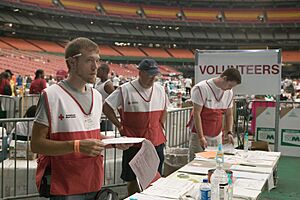
Forecasting a major disaster before the landfall of Hurricane Katrina, ARC enlisted 2,000 volunteers to be on a "stand by" deployment list.
According to ARC, during and after hurricanes Katrina, Wilma and Rita, they opened 1,470 shelters and registered 3.8 million overnight stays. 300,000 American Red Cross workers (82% unpaid) provided sheltering, casework, communication and assessment services throughout these events. In addition, 346,980 comfort kits (which contain hygiene essentials such as toothpaste, soap, washcloths and toys for children) and 205,360 cleanup kits (containing brooms, mops and bleach) were distributed. The organization served 68 million snacks and meals. Disaster Health services provided 596,810 contacts, and Disaster Mental Health services 826,590 contacts. Emergency financial assistance was provided to 1.4 million families, including 4 million people. Katrina was the first natural disaster in the United States that ARC utilized their "Safe and Well" family location website.
Comair Flight 5191
Following the crash of commuter aircraft Comair Flight 5191, the Bluegrass Area Chapter and ARC Critical Response Team (CRT) members were dispatched. This was the worst air disaster in the United States since American Airlines Flight 587. Family and Friends reception centers were established near the arrival and departure airports and in Cincinnati, site of the Comair headquarters. Local chapters in Georgia, Alabama, Kentucky and California provided health and mental health services to family and friends not present in Lexington. Volunteers also staffed the local Emergency Operations Center (EOC) in Lexington, Kentucky.
2007 tornadoes
Florida
In response to the Central Florida Tornado of February 2007, ARC began a large scale disaster relief operation. At least seven shelters were opened. 40,000 pre-packaged meals were sent by ARC, and across the nation, almost 400 American Red Cross volunteers were deployed to assist with local relief efforts. The organization deployed more than 30 Emergency Response Vehicles for community food and supply distribution.
Kansas
ARC immediately responded to the May 2007 Tornado Outbreak in central Kansas by setting up emergency shelters for displaced residents and started the distribution of food, water and relief supplies.
Minneapolis bridge collapse
Following the collapse of the I-35W Mississippi River bridge, the Twin Cities Area Chapter responded with their Disaster Action Team to provide food, information and comfort. A family service center was set up, and mental health counselors deployed to numerous locations. Donations contributed for this cause totaled US$138,368 and covered the cost of services but not $65,000 in unexpected expenses. Weather and the collapse placed 70% of Minnesota counties in federal primary or contiguous disaster areas during that August.
2023 Hawaii wildfires
Following the 2023 Hawaii wildfires in early August of 2023, the ARC began a large scale disaster relief operation (DRO). At the time of this writing, more than 1,300 volunteers have been deployed since the fires began. In partnership with the county government, the ARC gas been able to provide displaced residents with more than 257,000 overnight emergency shelter and hotel room stays on Maui and Oahu.
International services
ARC, as part of the International Red Cross and Red Crescent Movement and its nearly 100 million volunteers, educates and mobilizes communities to overcome life-threatening vulnerabilities. ARC International Services Department focuses on global health, disaster preparedness and response, Restoring Family Links and international humanitarian law dissemination. ARC is involved with international projects such as the measles Initiative, malaria programs in Africa, disaster response and relief efforts in response to the 2004 South Asia tsunami.
Global health
ARC International Services global health initiatives focus on preventing and combating infectious diseases such as HIV/AIDS and measles on a large scale. Through cost-effective, community-based health interventions, ARC targets people in need and focuses on accessibility and equity of care, community participation, and integration with other community development initiatives, such as water and sanitation projects and food and nutrition programs.
An example of ARC International Services health programming is the Measles Initiative, launched in 2001, as a partnership committed to reducing measles deaths globally. The initiative provides technical and financial support to governments and communities on vaccination campaigns and disease surveillance worldwide. Leading these efforts are ARC, the U.S. Centers for Disease Control and Prevention, the United Nations Foundation, UNICEF and the World Health Organization. The Measles Initiative has supported vaccination campaigns in more than 60 countries, mostly in Africa and Asia. Since 2001, the initiative has helped vaccinate one billion children in more than 60 developing countries. The initiative supported the distribution of more than 37 million insecticide-treated mosquito nets for malaria prevention, 81 million doses of de-worming medicine, 95 million doses of polio vaccine, and 186 million doses of vitamin A.
In December 2006, ARC became a founding partner of the Malaria No More campaign. The campaign was formed by leading non-governmental organizations to inspire individuals, institutions, and organizations in the private sector to support a comprehensive approach to end malaria, a devastating but preventable disease. ARC supported local Red Cross and Red Crescent volunteers in Africa who educated families and communities about malaria prevention and treatment, such as the proper and consistent use of insecticide-treated bed nets. ARC provided technical assistance and capacity-building support to its partners in difficult-to-reach communities.
International tracing requests
ARC handles international tracing requests and searches for families who have been separated. This service attempts to re-establish contact between separated family members. Restoring Family Links services provide the exchange of hand-written Red Cross Messages between individuals and their relatives who may be refugees or prisoners of war. At any given time, ARC Restoring Family Links program is handling the aftermath of 20–30 wars and conflicts. The worldwide structure of Red Cross and Red Crescent National Societies and the International Committee of the Red Cross make this service possible. When new information from former Soviet Union archives became available in the 1990s, a special unit was created to handle World War II and Holocaust tracing services.
International humanitarian law
ARC International Services educates the American public about the guiding principles of international humanitarian law (IHL) for conduct in warfare as set forth by the Geneva Conventions of 1949. In doing so, ARC International Services provides support to ARC chapters in their IHL dissemination efforts, offering courses and providing instructor training.
Service to the Armed Forces
ARC provides emergency and non-emergency services to the United States military. The most notable service is emergency family communications, where families can contact the Red Cross to send important family messages (such as a death in the family, or new birth). ARC can also act as a verifying agency. The agency operates call centers to provide these services. ARC works closely with other military societies, such as the Department of Veterans Affairs, to provide other services to service members and their families. ARC is not involved with prisoners of war; these are monitored by the International Committee of the Red Cross, the international body.
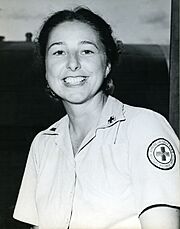
One criticism of American Red Cross services to the military stems from stories about ARC charging troops during the Second World War and Korean War token fees for "comfort items" such as toothpaste, coffee, donuts, and cigarettes and for off-base food and lodging. The fee suggestion had been made in a letter dated March 1942 from the Secretary of War Henry L. Stimson to Norman H. Davis, the chairman of ARC. The suggestion was that Allied soldiers were being charged money so Americans should be charged too so as to "ensure an equitable distribution among all service personnel of American Red Cross resources". The American Red Cross adopted the Secretary's suggestion as policy.
During World War II, ARC operated the American Red Cross Clubmobile Service to provide servicemen with food, entertainment and "a connection home." In a June 18, 1945, address to Congress, General Dwight D. Eisenhower said of the American Red Cross service in World War II, "The Red Cross, with its clubs for recreation, its coffee and doughnuts in the forward areas, its readiness to meet the needs of the well and to help minister to the wounded has often seemed the friendly hand of this nation, reaching across the sea to sustain its fighting men." An account of one World War II American Red Cross Girl is recorded in Destination Unknown by Kathleen Cox; her mother, LeOna Cox, was recruited to American Red Cross Service by a fellow teacher at Allegheny College. Another account of an American Red Cross World War II worker is related in letters by Evelyn Merritt Welden, compiled in the book How to Play During a War: A Free Spirit's Life in Letters, by her son, Lynne Whelden.
During the Vietnam War 627 American women served in the ARC Supplemental Recreation Overseas Program. At the invitation of the United States Army the "Donut Dollies" provided morale-boosting games to soldiers. Due to the mobility of the UH-1 Iroquois, Vietnam Donut Dollies were able to visit troops in forwarding operating positions. The 2008 documentary film A Touch of Home: The Vietnam War's Red Cross Girls tells the story of these women. ARC also provided services to entertain wounded soldiers at the Great Lakes Naval Hospital during the Vietnam War.
In 2011, the Service to the Armed Forces (SAF) unit was reorganized and began receiving $24 million per year from Congress for operating expenses. Along with being downsized there was a consolidation into four regional locations (San Diego, California, Ft. Sill, Oklahoma, Louisville, Kentucky, and Springfield, Massachusetts). In 2012 the first stories began breaking about long call times and the poor quality of response from call takers, along with questions about whether money was being used appropriately. In 2015, the San Diego and Springfield locations were closed because an online option for families was implemented.
See also
 In Spanish: Cruz Roja Americana para niños
In Spanish: Cruz Roja Americana para niños
- American Red Cross Motor Corps
- American Red Cross Volunteer Life Saving Corps


